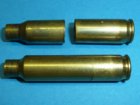I am relatively new to reloading and I am sure this question has poped up a few times, but
I couldnt find a definite answer with search.
I usually screw the die (lee full length) die into the press (rcbs partner) so that it touches the shellholder with the ram al the way up, and then I screw the die a bit more (1/8 of the turn).
If I screw the die more, do I bump the shoulders of the case further down, will I create excessive headspace on the cases this way?
Yesterday I was shooting my load for bergara hmr in 308 and I got bigger groups than usual, instead of 12mm they were like 60,70mm.
A friend of mine instantly checked for headspace by putting pieces of paper on bolt face, and then chambering a round. We could put 3 or 4 pieces of paper with some rounds.
If I remember correctly, I might have screwed the die a bit more than usual last time, but I was under the impression (and told so by more experienced reloaders) that it
doesnt matter how much I screw the die in the press, the shellholder is the full stop and it wont have any impact on case shoulders.
I couldnt find a definite answer with search.
I usually screw the die (lee full length) die into the press (rcbs partner) so that it touches the shellholder with the ram al the way up, and then I screw the die a bit more (1/8 of the turn).
If I screw the die more, do I bump the shoulders of the case further down, will I create excessive headspace on the cases this way?
Yesterday I was shooting my load for bergara hmr in 308 and I got bigger groups than usual, instead of 12mm they were like 60,70mm.
A friend of mine instantly checked for headspace by putting pieces of paper on bolt face, and then chambering a round. We could put 3 or 4 pieces of paper with some rounds.
If I remember correctly, I might have screwed the die a bit more than usual last time, but I was under the impression (and told so by more experienced reloaders) that it
doesnt matter how much I screw the die in the press, the shellholder is the full stop and it wont have any impact on case shoulders.












